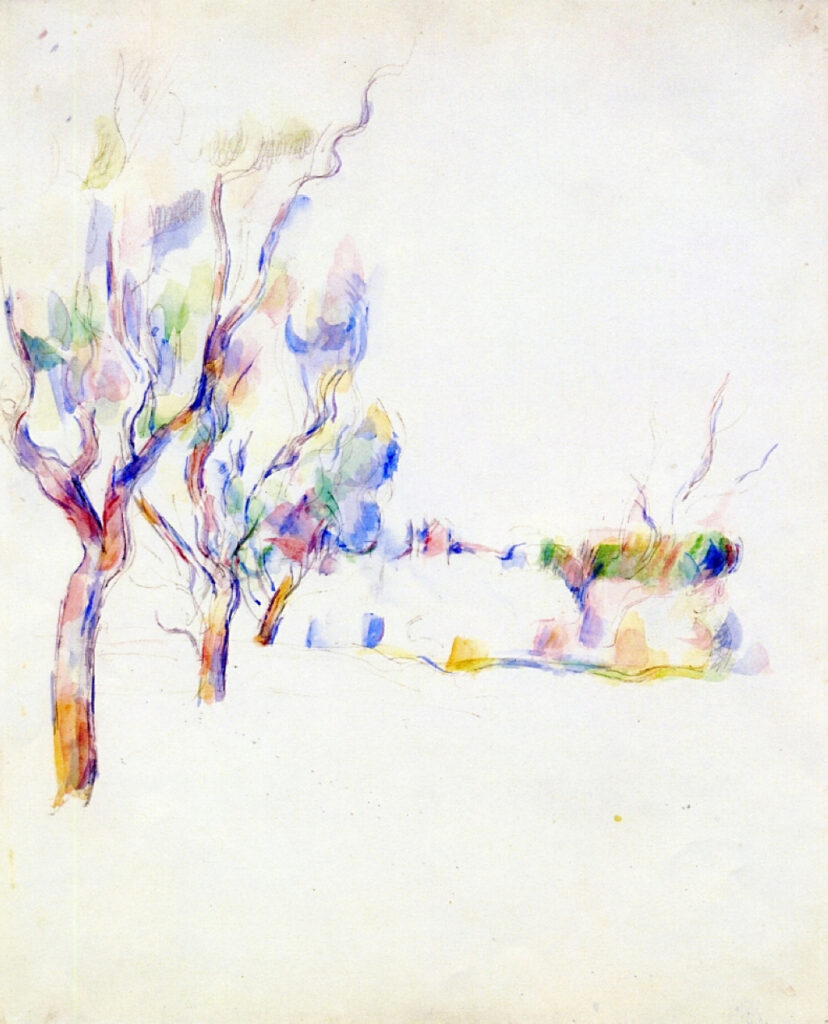A to Z of Landscapes: Trees 2

By the late nineteenth century, paintings of trees continued to be based largely on the anatomical method where trunk, branches and foliage were assembled in accordance with long-established teaching. Signs of change appeared in the radical landscapes of Vincent van Gogh and Paul Cézanne.
Vincent van Gogh (1853–1890), Blossoming Chestnut Tree (1887), oil on canvas, 56 x 46.5 cm, Van Gogh Museum, Amsterdam. Wikimedia Commons.
It was van Gogh’s Blossoming Chestnut Tree from 1887 that marks this departure, together with Paul Cézanne’s foliage built using constructive strokes. Although there are a couple of glimpses of the underlying trunk and branch structure, this chestnut in full leaf and flower has a more solid canopy built from visible and organised brushstrokes. These marks are starting to forms whorls and swirls in places, including the background vegetation. The tree is only demarcated from that background, the grass below, and trees behind, by discontinuity in the structure and orientation of the marks.
Vincent van Gogh (1853–1890), Cypresses (1889), oil on canvas, 93.4 x 74 cm, The Metropolitan Museum of Art, New York, NY. Wikimedia Commons.
Van Gogh’s series of Cypresses (1889) are some of the best-remembered of all. As he moved style on beyond Impressionism, his swirling brushstrokes form solid but thoroughly living trees.
Vincent van Gogh (1853–1890), Olive Grove (1889), oil on canvas, 72 x 92 cm, Kröller-Müller Museum, Otterlo. WikiArt.
In his Olive Grove from the same year, those swirling strokes of foliage complement the tortuous curves of the branches and blue trunks.
William Merritt Chase (1849-1916), Olive Trees, Florence (1911), oil on panel, 23.18 x 30.48 cm, Private collection. WikiArt.
It’s worth comparing William Merritt Chase’s later treatment of Olive Trees, Florence from 1911, with van Gogh’s above. Highlights among the leaves, in particular, are highly gestural, in places resembling the drips and runs that might be more characteristic of the later twentieth century.
Claude Monet (1840-1926), The Three Trees, Autumn (1891) W1308, oil on canvas, 92 x 73 cm, Private collection. WikiArt.
In 1891, Claude Monet painted series of poplar trees not far from his studio and home at Giverny. With their simpler anatomy, The Three Trees, Autumn is an example.
Camille Pissarro (1830–1903), Saint-Charles, Éragny (1891), oil on canvas, 81 x 65 cm, Clark Art Institute, Williamstown, MA. WikiArt.
Throughout his long and productive career, Camille Pissarro’s landscapes are rich with trees, and his trees are richly worked. This view into the low sun of Saint-Charles, Éragny from 1891 is as saturated in colour as that of Inness (in the previous article), but bears spots of colour marking his Divisionist style and its stippled detail.
Camille Pissarro (1830–1903), Automne, Peupliers, Éragny (Autumn, Poplars, Éragny) (1894), oil on canvas, 102.9 x 81.9 cm, Denver Art Museum, Denver, CO. Wikimedia Commons.
A few years later and that texture has changed in Pissarro’s Autumn, Poplars, Éragny from 1894, which captures their dry leaves so well that you can almost hear them rustling in the breeze.
Paul Cézanne (1839-1906), Almond Trees in Provence (1900). Graphite and watercolour on paper, 58.5 x 47.5 cm, private collection (WikiArt).
Paul Cézanne’s abundant oil paintings of trees show his emphasis on patterned brushstrokes, in his ‘constructive stroke’. This isn’t true of his watercolours, as shown in Almond Trees in Provence (1900), where each tree rises in a flare of bright colours.
Théo van Rysselberghe (1862-1926), Pine by the Mediterranean Sea (1916), oil on canvas, 81 x 199 cm, Centraal Museum, Utrecht. WikiArt.
Théo van Rysselberghe’s Pine by the Mediterranean Sea (1916) appears almost as substantial as the bleached rocks below it. Contrast between the lit segments and those in cast shadow behind is very wide, as is experienced on the shores of the Mediterranean.
Egon Schiele (1890–1918), Four Trees (1917), oil on canvas, 110 x 140.5 cm, Österreichische Galerie Belvedere, Vienna, Austria. Wikimedia Commons.
Finally, Egon Schiele’s Four Trees is an Expressionist work based on views in Austria, showing four stark chestnut trees in the setting sun of the autumn. Although modern, it still relies on the anatomical method of painting trees.




